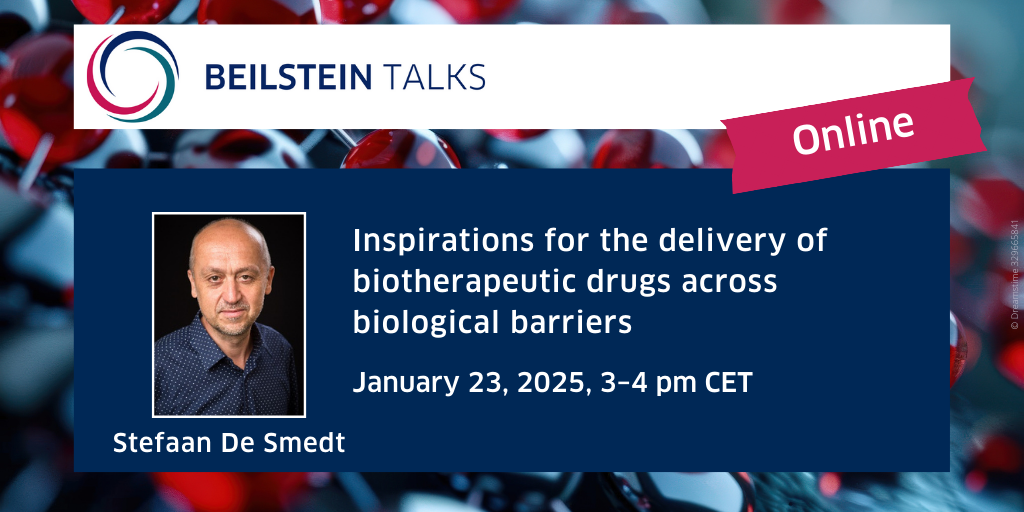Beilstein Talk on Inspirations for the delivery of biotherapeutic drugs across biological barriers

Beilstein Talks
The Beilstein Talks are an established addition to the Beilstein-Institut’s projects supporting communication and information in science. These online talks are free to attend; a simple registration is all that is required.
Inspirations for the delivery of biotherapeutic drugs across biological barriers
Stefaan de Smedt / Ghent University, Belgium
January 23, 2025, 3–4 pm CET
Online live talk
👉 Go to the free registration for the online live talk!
Introduction
Over the past 30 years protein bio-therapeutics experienced major clinical successes and nowadays represent the fastest growing category of drugs. Meanwhile, progress in the understanding of RNA biology has led to the identification of new RNA classes with unanticipated functions. Following these advances new therapeutic strategies based on nucleic acids have been introduced. Examples are single stranded antisense oligonucleotides, double stranded small interfering RNAs and microRNAs, all for inhibiting gene expression and, most recently, single guide RNAs for the editing of mutated genes. In addition to nucleic acids which silence or edit genes, there is a major interest as well in the therapeutic potential of messenger RNAs to express proteins in cells for e.g. vaccination to protect the population against infections or to treat cancer patients. As 30-40 years ago, when recombinant proteins and monoclonal antibodies began to be developed as therapeutics, it seems that with nucleic acid bio-therapeutics we are again on the brink of a revolution in drug development. Today the majority of clinically advanced nucleic acids are systemically injected and tested for liver associated diseases. However, numerous potential targets for nucleic acids are present in tissues beyond the liver, like in the lungs and the eyes, which can best be reached through local administration of the nucleic acids, like through inhalation in the lungs or local injections in the eye.
Fulfilling the therapeutic expectations of nucleic acids will however require to overcome major delivery hurdles, including how to keep them stable and how to deliver them across cellular, extra- and intracellular membranes into the cytosol. Currently, the packaging of nucleic acids into well designed nanoparticles (‘nanomedicines’) is the major approach taken to deliver them in cells. While major succeses have been achieved, it remains however of paramount importance not to forget that only a very low percentage (~ 1%) of systemically injected nucleic acids packaged in nanoparticles become successfully delivered at their targets. The lack of safe and efficient delivery technologies remains the major bottleneck for the breakthrough of nucleic bio-therapeutics.
At Ghent University we undertake efforts for a better understanding of the physicochemical and biopharmaceutical understanding of nanomedicines, including lipid nanoparticles (LNPs) loaded with nucleic acids, this to improve their delivery performance and safety. Though, while the clinical introduction of mRNA vaccines has boosted the interest and investments by the pharmaceutical industry into the further development of LNPs, at university we consider it our role to keep on trying to identify new concepts and strategies which might open new avenues for the delivery of bio-therapeutics to targets which cannot be reached through nanoencapsulation. This lecture will explain our recent efforts in finding strategies to deliver nucleic acids from the extracellular space, over cell- and organelle-membranes, into the cytosol. Both pharmaceutical, biological, physical and engineering aspects of our work will be highlighted. A special emphasis will be on the delivery of nucleic acids to targets in the eye.
👉 Go to the free registration for the online live talk!
16 Dec 2024






